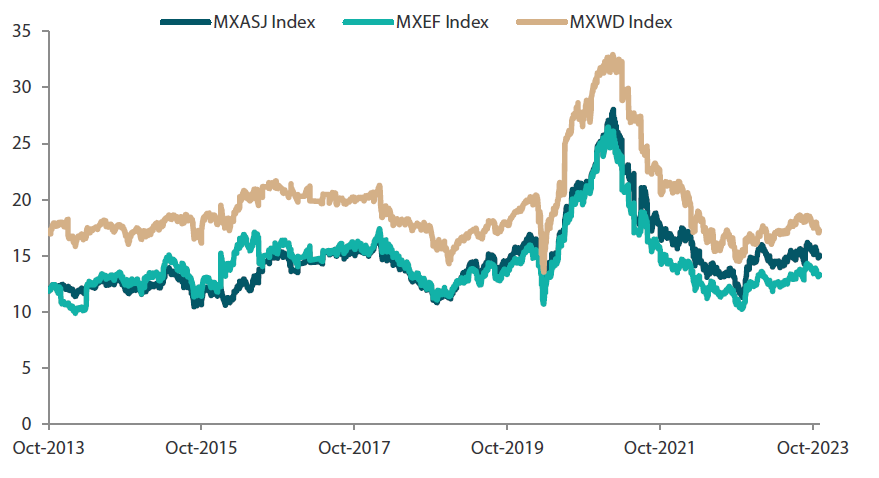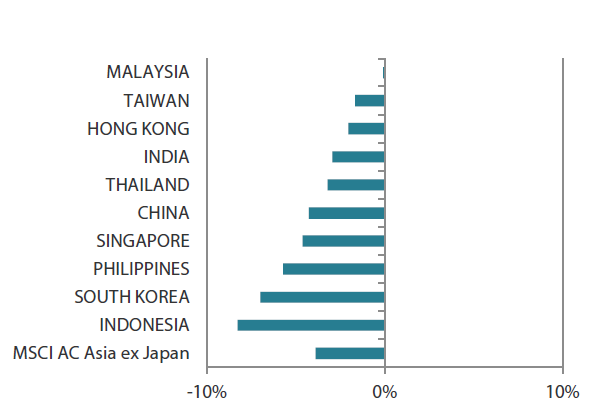Summary
- While the risk-off environment stretched into another month, we are still finding plenty of positives in Asia. India’s macro remains favourable; Chinese equity markets are near the cheapest in 20 years; and the semiconductor industry is showing signs of a bottoming. With the US potentially having reached peak interest rates, this could be a welcome backdrop for Asian markets going forward.
- For the month, the MSCI AC Asia ex Japan Index declined 3.9% in US dollar (USD) terms, weighed down by rising government bond yields amid the prospect of an extended period of high interest rates and concerns about the potential impact of the Israel-Hamas war.
- Indonesia (-8.3%), South Korea (-7.0%) and the Philippines (-5.7%) led the losses in October, whereas Malaysia (-0.1%) and Taiwan (-1.7%) performed relatively better.
- Earnings expectations and valuations in Asia remain attractive, but there is a disconnect forming between the fundamental outlook and investor confidence, in our view.
Market review
Asian markets slump for the third consecutive month
Regional equities, as measured by the MSCI AC Asia ex Japan Index, declined for the third-straight month, returning -3.9% in USD terms in October. All Asian markets closed the month in the red, weighed down by rising government bond yields amid the prospect of an extended period of high interest rates. Concerns about the potential impact of the Israel-Hamas war and an underwhelming corporate earnings season thus far also dented regional market sentiment.
Chart 1: 1-yr market performance of MSCI AC Asia ex Japan vs. Emerging Markets vs. All Country World Index

Source: Bloomberg, 31 October 2023. Returns are in USD. Past performance is not necessarily indicative of future performance.
Chart 2: MSCI AC Asia ex Japan versus Emerging Markets versus All Country World Index price-to-earnings

Source: Bloomberg, 31 October 2023. Returns are in USD. Past performance is not necessarily indicative of future performance.
South Korea and China lead the losses in North Asia
In China, stocks slumped 4.3% in October as investors continued to offload shares in the country, which is facing property sector woes and slower growth. China’s GDP grew 4.9% year-on-year (YoY) in the third quarter (3Q), beating market forecasts, but its manufacturing activity unexpectedly contracted in October, casting doubts over a sustained recovery in the world’s second-largest economy. During the month, China unveiled extra spending, widening its fiscal deficit to shore up economic recovery. The country’s consumer prices remained unchanged YoY in September. In Hong Kong, stocks sank 2.1% due to growing worries about China’s weak housing market and persistently high US interest rates. The debt default by Hong Kong-listed Chinese property developer Country Garden also dampened equity market sentiment.
Elsewhere, a downturn in global technology (tech) stocks, plus concerns that major central banks could keep interest rates higher for longer continued to dampen investment sentiment in the tech-centric market of South Korea, which slumped 7.0% in October. South Korea’s economy expanded 1.4% YoY in 3Q, following a gain of 0.9% in 2Q. In other developments, the Bank of Korea maintained its base rate at 3.5% during its October meeting, keeping rates unchanged for the sixth straight time. In Taiwan (-1.7%), stocks fared relatively better, supported by a recovery in exports, which rose 3.4% YoY in September, marking the first rise in more than a year. Meanwhile, inflation rates in Taiwan and South Korea inched higher in September from the previous month.
Indonesia nosedives 8.3%, while Malaysia fares relatively better
In the ASEAN region, Indonesia (-8.3%), the Philippines (-5.7%) and Singapore (-4.6%) were the worst-hit markets in October, whereas Thailand (-3.2%) and Malaysia (-0.1%) performed relatively better. During the month, several ASEAN central banks hiked interest rates to actively prevent currency weakness while guarding against inflation. The central bank of Indonesia defied expectations by raising its policy rate by a quarter-point to 6%, while its counterpart in the Philippines also surprised markets by increasing its benchmark interest rate by 25 basis points (bps) in an off-cycle move. Meanwhile in Singapore, the Monetary Authority of Singapore kept its exchange rate-based monetary policy settings unchanged; the central bank expects Singapore's economic growth to improve gradually over 2024. Thailand’s finance ministry lowered its 2023 economic growth forecast from 3.5% to 2.7%, due to weaker exports and lower government consumption. Elsewhere, Malaysia's 3Q GDP grew 3.3% YoY, according to advanced projections by the Department of Statistics Malaysia.
Indian equities track regional losses
For the month, Indian stocks fell 3.0%, tracking regional losses. Retail inflation in India eased to a three-month low of 5.02% in September as food prices moderated, and the Reserve Bank of India (RBI) maintained its key lending rate at 6.5% for the fourth consecutive time. India’s trade deficit narrowed more than expected, standing at USD 19.4 billion in September. Exports fell by 2.6%, while imports plunged 15% from a year earlier.
Chart 3: MSCI AC Asia ex Japan Index1
| For the month ending 31 October 2023 | For the year ending 31 October 2023 | |

|

|
Source: Bloomberg, 31 October 2023.
1Note: Equity returns refer to MSCI indices quoted in USD. Returns are based on historical prices. Past performance is not necessarily indicative of future performance.
Market outlook
Earnings expectations and valuations in Asia remain attractive
With three months of negative returns for the MSCI Asia ex Japan Index, investors are in a risk-off mood. Earnings expectations and valuations, however, remain attractive, but there is a disconnect forming between the fundamental outlook and investor confidence, in our view.
The persistently high and rising US rates interest rates, the challenging macro backdrop and two major military conflicts are all starting to bite. With the depreciating yen, rising rates in Japan and the Bank of Japan signalling that it may end its Yield Curve Control scheme, the risks continue to pile on.
The long-end of the US rate curve is rising and negatively impacting the markets. It is starting to reflect higher-for-longer inflation expectations. The US Federal Reserve is finding it harder to bring inflation under control with the country’s wage growth running ahead of consumer prices . Widening interest differentials between the US and Asian economies are putting pressure on Asian currencies. The Indonesian central bank unexpectedly raised rates by 25 bps in October to defend its depreciating currency. We expect other central banks to be vigilant and ready to take action to defend their currencies.
India’s macro backdrop stays favourable
Still, we believe that there are plenty of positives in the region. In India, which is facing a national election in 2024, the macro backdrop remains favourable, especially with its strong economy. The RBI is holding rates steady; real rates in India are zero; and the Indian government has ramped up its fiscal spending. Meanwhile, earnings expectations are rising and equity valuations are in line with historic averages. In our view, India will continue to draw global investor interest.
Support from the Chinese government to continue
The Chinese economy and debt risks may have bottomed, and equity markets in China are near the cheapest they have been in the last 20 years. The Chinese government has stated on multiple occasions that it is committed to supporting the economy, local governments and local government financing vehicles’ excessive debts. It is also focused on fixing the weak property market in China. In expectation of rising demand from Chinese fiscal stimulus, the commodity markets are holding up.
The semiconductor industry is seeing a recovery
In tech, we are starting to see a bottoming of the semiconductor industry with inventories reaching levels that suggest demand is recovering, which in turn will increase prices. Chipmakers of Taiwan and South Korea are expected to be the main beneficiaries of an upward turn in the cycle.
Growth profile change in Indonesia will favour companies focused on the local economy
In Indonesia, domestic spending and bank lending have recovered after the pandemic. We believe that this growth profile change in the country will favour companies focused on the local economy, be it in consumption or healthcare. The Indonesian central bank remains vigilant and committed to supporting a stable macro backdrop.
Chart 4: MSCI AC Asia ex Japan price-to-earnings

Source: Bloomberg, 31 October 2023. Ratios are computed in USD. The horizontal lines represent the average (the middle line) and one standard deviation on either side of this average for the period shown. Past performance is not necessarily indicative of future performance.
Chart 5: MSCI AC Asia ex Japan price-to-book

Source: Bloomberg, 31 October 2023. Ratios are computed in USD. The horizontal lines represent the average (the middle line) and one standard deviation on either side of this average for the period shown. Past performance is not necessarily indicative of future performance.
Reference to individual stocks is for illustration purpose only and does not guarantee their continued inclusion in the strategy’s portfolio, nor constitute a recommendation to buy or sell.



